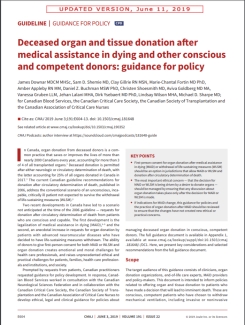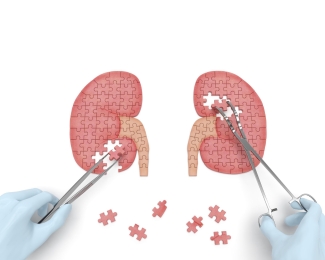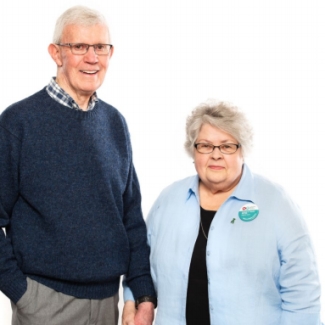Organ donation coordinators endure high rates of burnout. Canadian Blood Services and CHEO aim to change that.
Before Ken Lotherington joined the organ and tissue donation and transplantation (OTDT) team at Canadian Blood Services, he was employed within a hospital in Halifax. There, he worked directly with patient families as a tissue specialist and supported the donation program during organ and tissue recovery procedures.

“It was amazing, difficult and challenging work,” says Ken, who is based in Dartmouth, N.S. “Coordinators are one of the most critical roles that support organ and tissue donation. But folks who work in that role burnout and they burnout quickly — one of the reasons is working around death, grief and loss all of the time.”
In 2012, Ken left his job at the hospital and began a new career supporting the organ and tissue program at Canadian Blood Services. Now, working as a system development specialist, he’s facilitating world-leading research on burnout among organ and tissue donation coordinators, in partnership with the Children’s Hospital of Eastern Ontario (CHEO), to improve the system he used to work in.
Burning out
When Ken worked at the hospital, he helped facilitate the process when an organ and tissue donor died. Being from a relatively small community, there were times he recognized the name of a donor in a case he received.
“One was a young man I had played hockey with. He was at university, away from home. He was in an accident while skateboarding,” says Ken. “When you’re on shift, you often can’t say no to a case, because otherwise the donation isn’t going to happen.”
This case was difficult for Ken.
Without the tools to deal with the effects of secondary traumatic stress, compassion fatigue and other responses like moral distress, burnout is too often the result.
“Working at end of life all the time is challenging. It’s very intense. Sadly, the impact of burnout on these frontline workers is often job loss and sick leave, and in some cases, suicide,” he says.
Recognizing his own burnout was the driving factor behind Ken’s decision to leave his job at the hospital. Motivated to improve the system for others, he pursued a career at Canadian Blood Services to help shape policy.
“Personally, it inspires me. To have previously been a person suffering on the frontline, and now working collaboratively with the OTDT community to innovate and address issues like burnout for donor coordinators is just amazing,” he says. “What we’re doing really matters.”
Building resiliency
Unlike its leading role in operating the national blood, plasma and stem cell systems, Canadian Blood Services has a more indirect role when it comes to organs and tissues. The organization manages a national transplant registry that enables interprovincial organ sharing, but each province and territory are responsible for their own donation and transplant programs.
Liam Peyton, Hockey Gives Blood ambassador, shares why he joined the organ and tissue donor registry and how you can too.
Canadian Blood Services facilitates national collaboration to develop leading practices, support professional education and lead public awareness activities. The organization also analyzes data to improve the performance of Canada’s OTDT system.
Over the past year, Canadian Blood Services and CHEO’s project team has published numerous studies, reviews and research protocols on the causes and effects of burnout on frontline donation coordinators working in a hospital setting. The goal is to create tools and systems to better support those working in this essential role.
“We are actually world-leading in this area of research. We’ve been deliberate about publishing our research protocols and collaborating so that anyone, anywhere, can replicate our studies,” says Ken.
An active ambassador for Canadian Blood Services, Ken values the importance of sharing information to develop positive solutions. Already, international collaborators in Turkey, the United Kingdom and Japan are looking to leverage this research.
“We know burnout among this population isn’t isolated to Canada or North America. This is an issue worldwide,” Ken says. “Through this research, we’re hopefully going to have a tremendous impact on the system and build resiliency in the health-care sector.”
Anyone can be a potential organ and tissue donor regardless of age, medical condition or sexual orientation. Learn more about organ and tissue donation and transplantation and register your decision to become a donor. Join Canada’s Lifeline today.
Canadian Blood Services – Driving world-class innovation
Through discovery, development and applied research, Canadian Blood Services drives world-class innovation in blood transfusion, cellular therapy and transplantation—bringing clarity and insight to an increasingly complex healthcare future. Our dedicated research team and extended network of partners engage in exploratory and applied research to create new knowledge, inform and enhance best practices, contribute to the development of new services and technologies, and build capacity through training and collaboration. Find out more about our research impact.
The opinions reflected in this post are those of the author and do not necessarily reflect the opinions of Canadian Blood Services nor do they reflect the views of Health Canada or any other funding agency.
Related blog posts
A new publication in CMAJ ( Canadian Medical Association Journal ) aims to help health care teams navigate clinical issues surrounding organ and tissue donation by patients who choose to donate after medical assistance in dying (MAID) or withdrawal of life-sustaining measures. In collaboration with...
Five hundred kidney transplants made possible through national highly sensitized patient program
The 2017 Canadian Eye and Tissue Banking Statistics report is the first to include five consecutive years of data, allowing for new insight into provincial and national trends.


